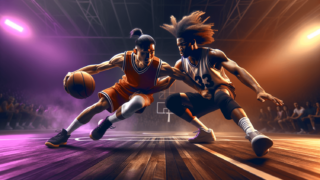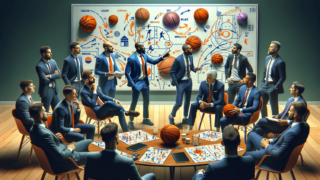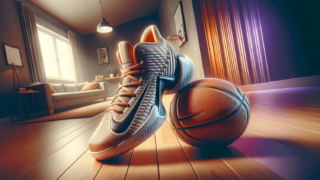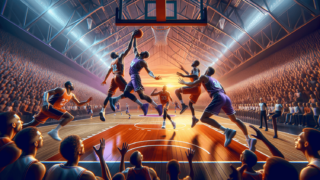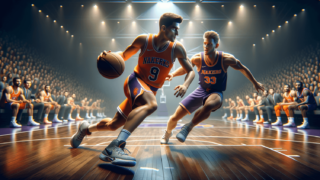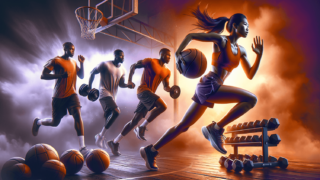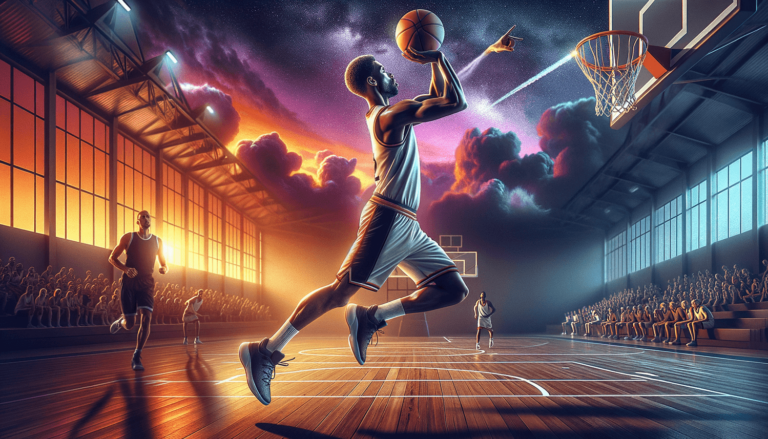
As the perfect blend of finesse, skill, and power, the art of the fadeaway shot has dazzled basketball enthusiasts for decades. Welcome to our deep dive into the mesmerizing world of one of basketball’s most iconic moves! If you’ve ever been captivated by the sight of your favorite player expertly navigating the court and sinking an unstoppable shot, then you’re in the right place. In this blog post, we’ll dissect the mechanics, history, and strategies associated with the enigmatic fadeaway shot, sure to delight hoops aficionados and relative newcomers alike. So, lace up your sneakers and let’s explore this extraordinary move together!
What Is a Fadeaway Shot in Basketball?
A fadeaway shot in basketball is a jump shot wherein the shooter leans backward while shooting, creating separation from the defender. This technique makes the shot more difficult to block but also increases the difficulty for the shooter, as it requires a high degree of skill, body control, and accuracy to execute effectively.
The Evolution of the Fadeaway Shot
The fadeaway shot has evolved into a staple move in the basketball world, originating back in the early years of the sport. First gaining prominence in the late 1960s, it transformed as new generations of players honed their skills and leveraged athleticism. To understand how the fadeaway shot became such an essential aspect of basketball, let’s walk through its history and the notable players that contributed to its development.
Early Days: The Origins of the Fadeaway
While the origins of the fadeaway are somewhat obscure, many believe that the shot was first popularized in the late 1960s by Elgin Baylor, a forward for the Los Angeles Lakers. Baylor’s unique style and smooth body control enabled him to execute magnificent fadeaways that left defenders reeling. Soon, other players began to incorporate the move into their arsenal, paving the way for more advanced variations.
The 1980s: Magic Johnson, Larry Bird, and Kareem Abdul-Jabbar
The 1980s saw the rise of Magic Johnson and Larry Bird, who frequently showcased their exceptional skill and versatility with the fadeaway shot. Additionally, Kareem Abdul-Jabbar, another NBA legend, utilized a particular form of fadeaway known as the skyhook. With his towering height and graceful shooting touch, Abdul-Jabbar made the skyhook a virtually unblockable shot, solidifying its place in basketball history.
The 1990s: Michael Jordan’s Mastery of the Fadeaway
No discussion of the fadeaway shot would be complete without mentioning the legendary Michael Jordan. The 1990s marked Jordan’s prime, and with his distinguished style, he made the fadeaway shot virtually synonymous with his name. Jordan’s impeccable footwork, hang time, and quick release enabled him to deliver the ball smoothly to the hoop, leaving countless defenders in his wake.
The 2000s and Beyond: Kobe Bryant, Dirk Nowitzki, and LeBron James
As the 21st century dawned, players like Kobe Bryant, Dirk Nowitzki, and LeBron James arrived to take the fadeaway shot into new territories. Bryant, a student of Jordan’s game, became an adept practitioner of the shot, even surpassing his mentor in some respects. Nowitzki brought a fresh twist to the fadeaway by blending it with his “one-legged” shooting style, creating a unique and almost unguardable move. Today, LeBron James demonstrates the fadeaway’s still-evolving potential with his power and precision while under duress on the court.
Breaking Down the Fadeaway Shot
Now that we’ve discussed the history of the fadeaway shot, it’s time to examine its mechanics and the techniques that make it such a compelling move in basketball.
The Footwork: Foundation of the Fadeaway
Mastering the fadeaway shot begins with solid footwork, which provides the necessary balance and stability during the shooting process. A strong pivot foot is crucial, as it enables the player to generate power and elevate above their defender. There are two primary footwork patterns in executing a fadeaway: the drop step and the jump step. Both styles require a coordinated shift of body weight and seamless transition from dribbling to shooting in order to maximize the accuracy and effectiveness of the attempt.
The Elevation: Gaining Altitude on Defenders
One of the critical aspects of executing a successful fadeaway shot is attaining the necessary height. As the shooter leans backward, elevation ensures that the shot becomes difficult for the defender to block. A proper jump, combined with an explosive upward thrust, helps get the ball over the outstretched hands of the defender. Core strength and leg power play a vital role in pushing the shooter’s body towards the apex of the jump and maintaining the necessary balance for precision.
Body Control: The Art of the Fadeaway
Perfecting the fadeaway shot demands exceptional body control. Coordinating the upper and lower body while leaning backward can be challenging, even for the most skilled players. But with consistent practice and repetition, body control can be significantly improved. Key areas to focus on include maintaining balance during the shot, coordinating the shooting hand’s release with lower body mechanics, and avoiding excessive drift during the fade.
The Release: Precision and Accuracy
The final component of the fadeaway shot is the release. It is essential that the shooter maintains a consistent and accurate shooting form, particularly when fading backward. As the shooting hand guides the ball’s motion, a prominent follow-through ensures a smoother and more precise trajectory. Since the fadeaway is inherently harder to execute than a standard jump shot, mastering the release requires persistent practice and attention to detail.
Implementing the Fadeaway Shot Into Your Game
Now that we’ve dissected the fadeaway shot’s mechanics, it’s time to implement this move into your basketball repertoire. With dedicated practice and an understanding of the strategies that make this shot so valuable, you can add this remarkable move to your on-court arsenal.
Know Your Angles
A key aspect of integrating the fadeaway shot into your game is understanding angles. Unlike a spot-up shooter, a fadeaway shooter must be acutely aware of their relative position to the hoop. Developing a sense of which positions on the court best suit your fadeaway can dramatically enhance your effectiveness and shooting percentage.
Exploit Mismatches
The fadeaway shot is particularly effective when exploiting mismatches on the court. If you’re a guard with a size advantage or a big man with outstanding shooting touch, using the fadeaway against a smaller or less agile defender can lead to easy buckets. Recognizing and seizing these opportunities can be the difference between a closely contested game and a comfortable victory.
Timing and Patience
To truly elevate your fadeaway game, patience is key. It’s crucial to recognize when to employ the shot and when to opt for a more straightforward attempt. A well-timed fadeaway can establish momentum and break the confidence of your defender, but continuously overusing the shot can lead to fatigue and low-percentage attempts. Finding the right balance of timing and patience is essential for maximizing the effectiveness of the fadeaway shot.
Defending the Fadeaway Shot
As a player looking to round out their basketball skills, it’s not only essential to master the fadeaway shot but also to know how to defend against it. Let’s explore some tips and strategies for handling this difficult-to-contend shot on the defensive side of the ball.
Anticipation and Recognition
One of the most effective ways to defend against a fadeaway shot is through anticipation and recognition. Understanding your opponent’s tendencies can alert you to the possibility of a fadeaway attempt, allowing you to adjust your defensive stance and improve your chances of contesting the shot.
Stay Close and Contest
Staying close to the offensive player and contesting their shot without fouling is vital to thwarting a fadeaway attempt. By narrowing the gap between you and the shooter, you minimize the offensive player’s window of opportunity, disrupting their shooting form and potentially forcing a bad shot or turnover.
Utilize Team Defense
A well-coordinated team defense can effectively neutralize a fadeaway shooter’s impact on the game. Employing defensive tactics like double-teaming, help defense, or strategically funneling the opponent into a race with a well-timed rotation can hinder the shooter’s ability to execute the fadeaway shot and diminish their overall effectiveness on the court.
Conclusion – The Allure and Impact of the Fadeaway Shot
Throughout its storied history, the fadeaway shot has become an iconic symbol of basketball, evoking images of legendary players and unforgettable plays. By understanding its mechanics, implementing the move into your game, and learning to defend against it, you can appreciate the beauty and significance of this extraordinary shot. With dedication and practice, perhaps you too will one day join the annals of basketball history with a fadeaway shot for the ages.
Famous Fadeaway Shots in Basketball History
As an homage to the fadeaway shot, let’s pay tribute to some of the most iconic fadeaway moments in basketball history. These awe-inspiring shots not only showcase the incredible skill and athleticism required to execute a fadeaway but also the clutch performances that captured the hearts of basketball fans worldwide.
Michael Jordan’s 1998 NBA Finals Game 6 Winner
Arguably one of the most famous fadeaway shots in basketball history, Michael Jordan’s Game 6 winner in the 1998 NBA Finals is etched in the annals of time. With the clock winding down and the Chicago Bulls trailing by one point, Jordan executed a textbook fadeaway shot over Utah Jazz defender Bryon Russell to sink the championship-winning basket. This shot would become the final exclamation point in Jordan’s illustrious career with the Bulls.
Kobe Bryant’s 2004 Playoff Game-Winner Against the Phoenix Suns
Renowned for his exceptional fadeaway prowess, Kobe Bryant’s 2004 playoff game-winner against the Phoenix Suns is a testament not only to his skill but also to his tremendous determination. This remarkable shot exhibited a masterful display of footwork and concentration, with Bryant arching the ball perfectly over an outstretched defender to secure the victory for the Los Angeles Lakers.
LeBron James’ 2018 Eastern Conference Finals Game-Winner
In Game 3 of the 2018 Eastern Conference Finals, LeBron James added his name to the list of fadeaway legends with an incredible shot that will forever be remembered by basketball fans. With time expiring and the Cleveland Cavaliers tied against the Toronto Raptors, James dribbled the length of the court and pulled up for a fadeaway jumper at the buzzer, demonstrating his unmatched skill and ability to perform under pressure.
Tips for Practicing Your Fadeaway Shot
Incorporating the fadeaway shot into your own repertoire requires dedicated practice and refinement. Below are some helpful tips to ensure that you’re maximizing your potential and steadily improving your skills on the court.
Begin with the Fundamentals
Before diving headfirst into the world of fadeaway shots, it’s essential to have a strong foundation in the fundamentals of basketball shooting. Work on perfecting your shooting form, balance, and footwork to set the stage for a successful transition to the fadeaway.
Start Close to the Rim
When first practicing your fadeaway, it’s helpful to start close to the rim. This method allows you to focus on mastering the mechanics of the shot without the added pressure of long-range shooting. Gradually move further back as you become more confident and comfortable with your fadeaway technique.
Utilize Drills and Repetition
Repeat drills focused on the different components of the fadeaway shot can significantly impact your overall progress. Concentrate on exercises that target footwork, elevation, and shooting accuracy, and don’t be afraid to mix in game-like scenarios to better prepare for real on-court situations.
Study Film of the Greats
Watching and analyzing film of legendary players who excelled at the fadeaway shot, such as Michael Jordan, Kobe Bryant, and Dirk Nowitzki, can provide essential insights and inspiration. Identify common techniques and moves they use during games, and try to emulate these skills during your practice sessions.
Be Patient and Persistent
Remember, the fadeaway shot is inherently difficult and requires consistent practice to master. Maintain patience and persistence in your training, and stay committed to sharpening your skills. With time and dedication, you will undoubtedly see your fadeaway shot improve, becoming a valuable weapon in your basketball arsenal.
Frequently Asked Questions
Below is a comprehensive collection of frequently asked questions surrounding the captivating topic of the fadeaway shot in basketball. This FAQ section is designed to address any lingering queries you might have and to expand your knowledge and understanding of this signature move.
1. Why is the fadeaway shot so difficult to execute?
The fadeaway shot is challenging to execute primarily because it requires exceptional body control, balance, and shooting accuracy. The shooter must maintain proper form while leaning backward and jumping, making it more difficult than a standard jump shot.
2. Is the fadeaway shot a high-percentage shot?
Generally, the fadeaway shot is considered a lower-percentage shot due to its inherent difficulty. However, skilled players who have mastered the move can still achieve relatively high shooting percentages with the fadeaway.
3. Who is considered the best fadeaway shooter in basketball history?
While it’s subjective, many people regard Michael Jordan as the best fadeaway shooter in basketball history due to his incredible skill, athleticism, and ability to make difficult shots under pressure.
4. Can shorter players effectively utilize the fadeaway shot?
Yes, shorter players can still effectively utilize the fadeaway shot, especially when facing taller defenders. Agility and a rapid release are essential for shorter players to succeed with this move.
5. How can I improve my shooting accuracy for fadeaway shots?
Improving shooting accuracy for fadeaway shots can be achieved through consistent practice, focusing on shooting mechanics, maintaining proper form, and learning from the great fadeaway shooters throughout basketball history.
6. What are the advantages of having a fadeaway shot in my skillset?
Having a fadeaway shot in your skillset provides an additional scoring option, creates mismatches on the court, and makes it more challenging for defenders to block your shot, ultimately increasing your offensive versatility.
7. How long does it typically take to master the fadeaway shot?
The time it takes to master the fadeaway shot varies for each player and depends on factors such as prior experience, natural ability, and dedication to practice. With consistent effort and focus, significant progress can be achieved over time.
8. What role does footwork play in the fadeaway shot?
Footwork plays a critical role in the fadeaway shot, as it provides balance, stability, and allows the shooter to generate power when elevating above their defender. Strong footwork is the foundation of an effective fadeaway.
9. How do I defend a fadeaway shot?
To defend a fadeaway shot, anticipate and recognize the shooter’s tendencies, stay close without fouling, contest the shot effectively, and employ well-coordinated team defense strategies.
10. Are there specific practice drills designed for improving the fadeaway shot?
Yes, there are specific practice drills focused on improving the fadeaway shot, which can target footwork, elevation, body control, and shooting accuracy. Combining these drills with game-like scenarios will lead to more significant progress.
11. Can the fadeaway shot be used in different offensive systems?
Yes, the fadeaway shot can be used in various offensive systems, as it provides an added dimension to the team’s attack, creates mismatches, and challenges defenders under different strategic approaches.
12. How does playing in different positions affect the effectiveness of the fadeaway shot?
Playing in different positions affects the effectiveness of the fadeaway shot based on each position’s skill demands and responsibilities. Guards may rely more on agility and speed, while forwards and centers may leverage their size and strength to succeed with the fadeaway.
13. Which current NBA players are known for having exceptional fadeaway shots?
Some current NBA players known for their exceptional fadeaway shots include LeBron James, Kevin Durant, and Stephen Curry, along with other up-and-coming stars who continue to enhance their skills with this signature move.
Featured Posts
- No pillar pages found.
